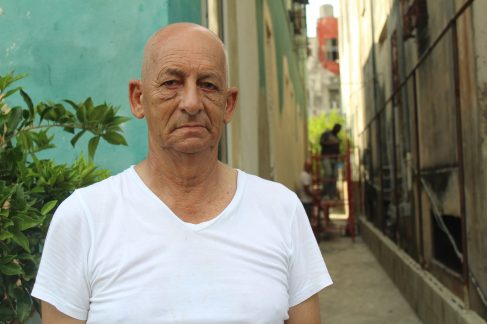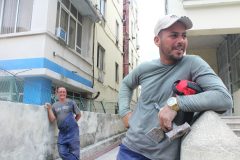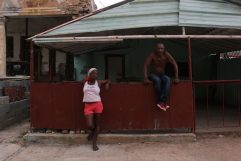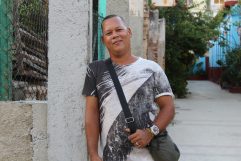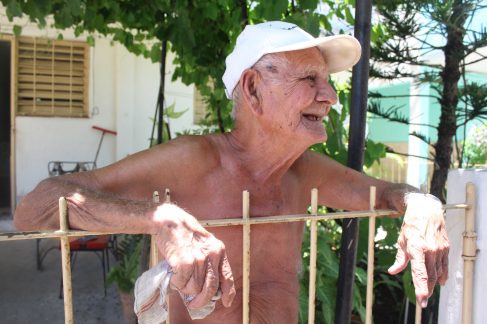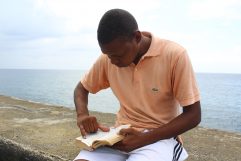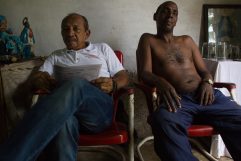Danielle Thompson
Danielle Thompson is a Communications major at Cal State East Bay. When not in school, she works as a media arts teaching assistant to students in Oakland. She has a passion for travelling, telling stories, and helping people. One day, she hopes to be an Oscar Award winning film maker.
Portrait Series
While in Havana, one of my favorite activities to do was to speak with and take portraits of locals. Though my Spanish is limited, many people were eager to get their photo taken by me; a very excited, American college student. Here is a series of their portraits.
Learning about Santeria
Walking into a church of Santeria for the first time felt surprisingly familiar and normal. There were lit statues of saints around the perimeter, isles of pews, and an altar at the front. I attended Catholic school and Catholic services up until the 11th grade so this was nothing new. Before travelling to Cuba, I pictured Santeria as this dark practice that was done in secret with dead animals and superstitious believers. And make no mistake, there are sacrifices and hexes within the religion but that’s not all that it is. I knew absolutely nothing about it other than stereotypes that I’ve learned from the media. Now that I’ve been exposed to it, all of the stereotypes that I had are gone. I don’t know everything about it because it’s a very complex belief system; but, I do know a bit more about where it came from, why animals are sacrificed, and how it’s practiced.
Before travelling to Cuba, I had limited knowledge on the religion. I knew that it was somehow influenced by the slave trade, they sometimes sacrificed animals, and that there are multiple deities within. My view of it was also influenced by the media. Recently, celebrity musician Azealia Banks was in the headlines for sacrificing chickens. When you google “Azealia Banks chicken” the top results are attention-grabbing, false titles like: “Azealia Banks Admits to Practicing Witchcraft for Three Years”. I remember when this story broke. On my personal social media accounts, people were insulting her and using it to defame her. They referred to Santeria as witchcraft, they were upset that she was harming animals. etc. However, I learned that sacrificing animals is an important aspect of the religion and anyone who eats meat shouldn’t have anything negative to say about it.
Within Santeria, they give blood offerings to the Orishas or Saints.The blood is offered to the Orisha while the meat of the animal is consumed. Nothing is wasted. This is unless the sacrifice is for healing. If so, the sickness goes through the animal and the meat is not consumed and the person may be healed. When Banks revealed that she has been sacrificing chickens, it was simply for her religion not for fun or sport. This may seem strange to others because larger religions like Christianity don’t make offerings in this way to God. However, different cultures worship in different ways and I now love learning these differences in practices.
One thing that Catholics and Santeros have in common is their inclusion of saints within their religion. Santeros call them Orishas. Because of the history of Santeria and how it used to be practiced in secret, each Orisha has a Catholic equivalent. For example, Chango is the Santero equivalent of Santa Barbara. I had no idea that Santeria and Roman Catholicism were so in line or that it was influenced by Catholicism in any form. I thought that the two were completely separate. This is why the churches that I visited in Cuba looked like any other Catholic church. One difference that can be spotted is the skin color of the statues. The statues tend to have dark brown skin rather than porcelain white skin. That is because it is an African religion so the saints tend to reflect this fact.
The first church that I visited had a line of ladies sitting outside of it. They were giving palm readings and selling flowers, cleansings, and necklaces that correspond with each Orisha. This is something that I’m not sure whether to believe in or not. When my palm was read, she told me that love will come to me. I thought that this was very generic and I wasn’t too happy. They continuously tried to get me to pay for flowers so they can “cleanse” me even after I refused multiple times. However, one of my classmates had a different experience. The previous night he had a dream about his grandmother and the woman mentioned his grandmother during his palm reading. He was, in his words, pretty creeped out by that. I still haven’t decided whether that was real or just a coincidence but I never believe in paying to have one’s energy cleansed. Situations when they tell you to purchase something for protection are almost always a scam. This is one encounter that I had with Santeria that was not as educational as the others.
Despite that one experience, overall, my world perspective broadened so much. As stated before, I’m not an expert on Santeria. I don’t understand everything about it. To my knowledge, it takes years to become an experienced and well versed Santero. However, learning what I do know now helped me break the stereotype that I had. That’s one thing that I love about travelling because I get to learn about a culture with my own eyes and not through someone else’s perspective.
I was also able to learn something significant to me. I’m a black descendent of slaves so this ties directly to my ancestors. I don’t know much about my family or my heritage or what countries I descended from but I feel more connected by learning about the religion of my ancestors. Santeria isn’t the original religion that they practiced but it is similar. I may never know much about my familial ancestors but I will always take this learning experience with me. It will remind me to always remain open minded to the ways that other people live.

